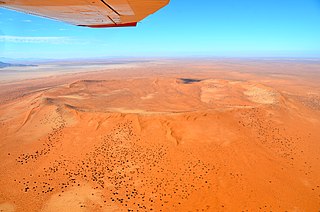Related Research Articles

Marquez crater is a meteorite crater located in Leon County, Texas near the small town of Marquez about 177 km (110 mi) northeast of Austin, Texas, United States.

Roter Kamm is a meteorite crater, located in the Sperrgebiet, within the Namibian section of the Namib Desert, approximately 80 kilometres (50 mi) north of Oranjemund and 12 kilometres (7.5 mi) southwest of Aurus Mountain in the ǁKaras Region. The crater is 2.5 kilometres (1.6 mi) in diameter and is 130 metres (430 ft) deep. The age is estimated at 4.81 ± 0.5 Ma, placing it in the Pliocene. The crater is exposed at the surface, but its original floor is covered by sand deposits at least 100 metres (330 ft) thick.

Sierra Madera crater is a meteorite crater (astrobleme) in southwestern Pecos County, Texas, United States. The central peak of the rebound structure of the impact crater rises 793 ft (242 m) above the surrounding land. The peak is visible from U.S. Highway 385 between Fort Stockton, Texas and Marathon, Texas. The Sierra Madera crater is located on private property on the La Escalera Ranch.

The Weaubleau structure is a probable meteorite impact site in western Missouri near the towns of Gerster, Iconium, Osceola, and Vista. It is believed to have been caused by a 1,200 feet (370 m) meteoroid between 335 and 340 million years ago during the middle Mississippian Period . It is listed by the Impact Field Studies Group as a "probable" impact structure.

The Earth Impact Database is a database of confirmed impact structures or craters on Earth. It was initiated in 1955 by the Dominion Observatory, Ottawa, under the direction of Carlyle S. Beals. Since 2001, it has been maintained as a not-for-profit source of information at the Planetary and Space Science Centre at the University of New Brunswick, Canada.

The Victoria Island structure is a 5.5 km (3 mi) bowl-shaped structure buried in the shale sediments of the Sacramento-San Joaquin River Delta, 12 miles (19 km) west of Stockton, California. The circular structure is part of a former sea bed, and lies 1,490–1,600 meters (4,890–4,250 ft) below sea level.

Ramgarh crater, also known as Ramgarh structure, Ramgarh Dome and Ramgarh astrobleme, is a meteor impact crater of 3.5 kilometres (2.2 mi) diameter in Kota plateau of Vindhya range located adjacent to Ramgarh village in Mangrol tehsil of Baran district in Rajasthan state of India. When formally accepted as the third crater in India, its diameter size would be between the two already confirmed craters in India - Dhala in Madhya Pradesh with 14 km diameter and Lonar in Buldhana district of Maharashtra with 1.8 km diameter.
Peter H. Schultz is Professor of Geological Sciences at Brown University specializing in the study of planetary geology, impact cratering on the Earth and other objects in the Solar System, and volcanic modifications of planetary surfaces. He was co-investigator to the NASA Science Mission Directorate spacecraft Deep Impact and the Lunar Crater Observation and Sensing Satellite (LCROSS). He was awarded the Barringer Medal of the Meteoritical Society in 2004 for his theoretical and experimental studies of impact craters.

The Massive Australian Precambrian/Cambrian Impact Structure also known as MAPCIS is a proposed impact structure based upon arguments presented by Daniel P. Connelly, a pharmacist, at Geological Society of America meetings. It is located approximately equidistant between Uluru and Mount Conner in the Northern Territory of Australia. The structure is approximately 600 km (370 mi) in diameter. However, a hypothetical outermost ring 2,000 kilometres (1,200 mi) in diameter is claimed to be the result of undefined far field stresses.

Traces of Catastrophe: A Handbook of Shock-Metamorphic Effects in Terrestrial Meteorite Impact Structures is a book written by Bevan M. French of the Smithsonian Institution. It is a comprehensive technical reference on the science of impact craters. It was published in 1998 by the Lunar and Planetary Institute (LPI), which is part of the Universities Space Research Association (USRA). It was originally available in hard copy from LPI, but is now only available as a portable document format (PDF) e-book free download.

Kaveri Crater is an area identified by scientists in India which appears to have been created by an asteroid impact that occurred around 800 to 550 million years ago. The area lying between Nilgiris and Kodaikanal is in the southern peninsular India. A study indicated that the Kaveri crater has a diameter of 120 kilometres. Because of the size of the crater, Kaveri crater can only be visualized through satellite images. The crater is the fourth largest crater in the world.
References
- ↑ "Impact Field Studies Group". University of Tennessee, Knoxville. Archived from the original on August 16, 2014. Retrieved 2009-08-17.
- ↑ Verish, Robert (July 2005). "Impact Field Studies Group". Bob's Findings. Meteorite Times. Retrieved 2009-08-17.
- ↑ Rajmon, David (2009-07-01). "Impact database 2009.1". Impact Field Studies Group. Retrieved 2009-08-17.
- ↑ Rajmon, David (March 13–17, 2006). "Suspected Earth Impact Sites" (PDF). Lunar and Planetary Institute . Retrieved 2008-09-24.
- ↑ Rajmon, David. "Impact Database: How to Contribute". Impact Database. Impact Field Studies Group. Retrieved 2011-09-02.
- ↑ Stockstill, Karen; F. Scott Anderson & Victoria Hamilton (2006). "Terrestrial analog study: Sierra Madera impact structure, Texas". NASA Astrobiology Institute Annual Reports. NASA. Archived from the original on 2011-07-21. Retrieved 2009-08-17.

